Gotham Chamber Opera (www.gothamchamberopera.com) in New
York has existed for ten years because it has been led by Neal Goren, who
founded the company in 2000 and has conducted its acclaimed productions of
Mozart’s Il Sogno di Scipione, Martinu’s Les Larmes de
Couteau, Sutermeister’s Die Schwarze Spinne, Handel’s
Arianna in Creta, Rossini’s Il Signor Bruschino,
Respighi’s La Bella dormente nel Bosco, Britten’s
Albert Herring, Haydn’s L’Isola Disabitata and,
coming up, Haydn’s Il Mondo della Luna (The World on the Moon),
which will be given at the Hayden Planetarium, January 19-28.
John Yohalem, for Opera Today: How did you decide to perform Haydn
in the Planetarium? How did you get the Planetarium?
Neal Goren: Well, it’s big for chamber opera, true. It’s
big in the sense that – Diane Paulus is directing, who directed
the revival of Hair in Central Park and on Broadway and has done a lot
of opera for Chicago Opera Theater, Mozart, all three Monteverdi operas.
But I’ll tell you the genesis for this. When I was thinking about the
opera, Haydn’s Il Mondo della Luna, I looked at the
orchestration and the chorus and realized it could never fit in the pit at
Henry Street. Where could we do this piece? I was thinking of alternative
spaces, empty space, you know? Some cool place. Diane did her version of
Midsummer Night’s Dream, The Donkey Show, in an old defunct
disco on the West Side some years ago. And I thought, The second act supposedly
takes place on the Moon, the first act in an amateur’s home observatory
– let’s see about doing it in the Hayden Planetarium. And Diane is
working with the engineers from the Rose Center [for Earth and Space] –
so at the point when the characters go to the Moon, the audience is going to go
to the Moon, as well – we’re going to have video projections on the
180-degree dome that were produced by NASA and the museum, we’re going to
have it go to the music.
JY: Who did you call at the Museum of Natural History?
NG: We started at the top. That’s the only way, is to start at the
top.
JY: They probably don’t read letters like that every day.
NG: We’re taking the opera and cutting it down. I cut the Handel a
lot, too. As I think you mentioned in your review of L’Isola
Disabitata, Haydn often has problems with the dramaturgy. Less so in
L’Isola, which only has four characters, but most Haydn operas
are quite long, including Il Mondo della Luna – also, the music
is of variable quality. There’s probably an hour and a half of great
music, probably an hour of good music, there’s probably two hours of
really formulaic Haydn. So we’re cutting the piece down to an hour and a
half. Rather than presenting the Haydn opera, it’s really more a
celebration of the technology, an event using Haydn – but great musical
values; we’ve got some unbelievable singers for it, full orchestra and
everything. We thought we’d do better making it a successful evening for
the audience, interesting dramatically, and cutting the opera and making it
concise – than presenting the whole opera and making it a bore.
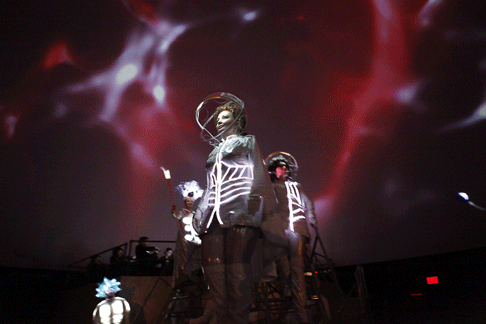 Pictured (left to right): Timothy Kuhn, Matthew Tuell, Albina Shagimuratova, Hanan Alattar
Pictured (left to right): Timothy Kuhn, Matthew Tuell, Albina Shagimuratova, Hanan Alattar
JY: How would you define chamber opera?
NG: It’s a variable term. If it’s something the composer wrote
for a chamber orchestra, then it’s a chamber opera. That can vary from a
handful of instruments, a pocket opera – eight instruments, say –
that’s about as small as I can think of – all the way up to
Respighi. The minimum we could do the Bella dormente nel Bosco that we
did was thirty-two or thirty-four instruments, and so for him that’s
“chamber.” Whereas with Respighi’s La Fiamma,
there’s ninety-five or something. But I think anything within that range
would qualify as a chamber opera. If you’re talking about Handel operas
being paradigmatic chamber operas – well, they vary – from Acis
and Galatea, which was composed for a private theater, while Giulio
Cesare calls for trumpets and timpani – you need enough other forces
to balance them.
So what is a chamber opera? It’s something that can fit in one of the
theaters that I’m performing in – in the pit or on the stage.
There’s your answer.
Albert Herring, for example – no chorus, orchestra of thirteen.
Definitely a chamber opera. But the cast is gigantic – twelve big solo
roles. When you think of twelve big solo roles, you think of big opera –
Meyerbeer or something. So everything is a little askew there. I think if
it’s a chamber orchestra and fits in a theater with a thousand seats or
less, then it’s a chamber opera.
JY: I get the idea, reading the lives of journeyman composers, that they
wrote for whatever forces were available.
NG: Exactly. There are always these questions – especially in the
eighteenth century. When we did Mozart’s Il Sogno di Scipione, I
think there was only one number that the bassoons were included in.
Why? And another number with oboes, too…
JY: They’re both double reeds; perhaps the same musicians were
expected to play both.
NG: No, I think the bassoons were expected to double with the celli and the
bass. Not all the time, but most of the time. So it was up to the composer
– these days to the conductor – to decide when to let them sit
down, when they want that added color – and they only put in a special
bassoon part when it was a special bassoon part in addition to the cellos. And
oboes would play with the violins. Things like that. So it’s infinitely
expandable – if you didn’t have this instrument, you’d use
that instrument. You know – when Lohengrin was premiered –
Weimar, was it? Under Liszt? – the orchestra was less than forty.
Something pathetic. Can you imagine? Even in the prelude, with four first
violins?
JY: The singers must have been happy.
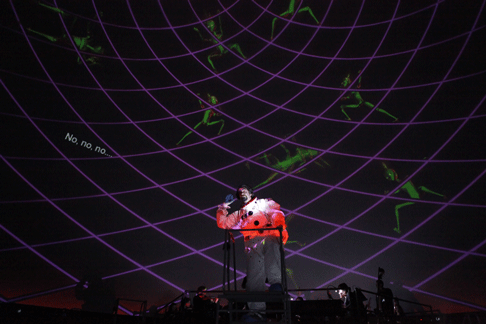 Pictured: Marco Nisticò
Pictured: Marco Nisticò
NG: You make the most of what you have.
JY: What was your initial impulse in starting the company?
NG: My background was mostly as a pianist. I came up with the idea in 2000,
our first production – Il Sogno di Scipione – was in 2001.
By that time I’d become relatively disenchanted with being an
accompanist. For many years before that people had perceived me as a conductor.
I was not ready to accept that yet, but when I was living in London, I was
playing auditions for the Italian Cultural Institute – for orchestra
members and also for singers in the chorus, for Rome Opera, Firenze, La Fenice.
And whoever was there, at the end of the auditions, said, “Oh, would you
like to come – there’s a job for an assistant conductor, and
eventually working your way up.” And I said, “Oh no, I’m not
a conductor.” Then the same thing happened at the Berlin Opera, when I
was doing auditions for Porgy and Bess, when they were doing it for
the first time at the Theater des Westens a hundred years ago. Everyone was
saying I was a conductor. I was playing rehearsals for Bernstein when he and
Thomas Hampson were making that incredible recording of Mahler songs, and
Bernstein said, “So, maestro, where are you conducting?” and I
said, “I’m not a conductor, I’m a pianist,” and he
said, “It’s time to reconsider that. Everything about you screams
Conductor.”
That led to an internal dialogue, because it’s a very different thing
seeing yourself as an accompanist and seeing yourself as a conductor. One is
essentially a follower, the other is a leader. But as the years went on, these
seeds having been planted, I became more and more dissatisfied with being an
accompanist. I was often playing for people who were great, but they were the
ones calling the shots. When I no longer found that terribly interesting, I
decided I would explore conducting.
Then a friend of mine became head of the music at the Henry Street
Settlement. He said they had a theater there that I should see. I fell in love
with the space. And I realized what New York needed was an opera company for a
smaller venue, because we have two of the great companies in the world for big
operas. So the theater was actually the impetus for the company. I could use
that as my laboratory as a conductor, but it was also a company the city
needed.
Of course I started from the musical angle. I had been assistant conductor
at the Mostly Mozart Festival, which in most such situations means a glorified
rehearsal pianist, and they had done Il Sogno di Scipione with Pamela
Coburn and Renée Fleming, in 1991 or so. I thought it was an amazing piece but
dramatically inert – to say the least. I remember looking at the score
and thinking it was a terrifying piece, and the tenor parts – just
impossible. For the leading tenor, you need a heldentenor, but you
need to have a great low C and a great high C and be able to do the fastest
sixteenth notes in the world. But I thought, I know enough singers who are
young enough, hungry enough and anxious to prove themselves that they could do
it.
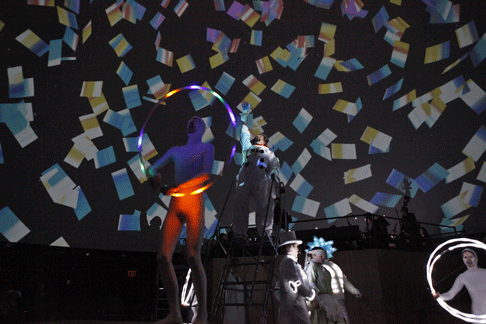 Pictured: Marco Nisticò (center)
Pictured: Marco Nisticò (center)
Now, I thought for a kickoff we’d need a director who would have some
legitimacy, who had been around. So I called Christopher Alden whom I had
worked with and told him about the project, and he was extremely apprehensive,
he said, “No, no new opera companies, and what was it we wanted to
do?” and I told him the books all say Il Sogno di Scipione is
unstageable, and he said, “What! There is no such thing. Send me the
score right away.” So he took up the challenge and there you go!
But how do you pay for it? So first thing Christopher did was, he talked to
each of the designers we wanted and we found out what was the least amount of
money that was needed for the designers to be proud of their work. So I said,
If I’m unable to raise that amount of money then we won’t do
anything – because the only thing worse than no opera is bad opera. From
the very beginning, it was about the proper quality. Not lavish. The bottom
line is that every designer be proud of their work. If we can go above that,
all the better. That’s what we’ve stuck to.
It was very, very difficult, as it always is pushing a stone uphill. But the
first season I asked everyone I knew if they knew anyone who might be able to
help. I compiled a list from the patrons, the donors of the Met, the City
Opera, BAM, the society pages of the Times, and we narrowed it down to
ten or fifteen people whose names kept recurring. I asked everyone I knew if
anyone knew these people – because I’d spent my whole life either
in the practice room or on stage. And, No, no, no, no, no – until I found
one person who knew one person – and introduced me to her. And the
network began. And we raised just enough money in the first production to cover
expenses, and that’s how it’s been essentially every year.
The good thing is that we’ve never had a line of credit. Because
we’ve never had a line of credit, we’ve never been able to
overspend. We’ve never had the luxury of overspending. Therefore
we’re not in the hole – and we still exist – unlike a lot of
other companies right now who relied on a line of credit on the assumption that
future donations would equal or surpass present donations. What we’ve
always seen as a terrible disadvantage has turned out to be in our favor, and
the reason we still exist.
JY: You have spoken of getting some help – around the Martinu and the
Sutermeister operas –
NG: Yes, we learned quickly about raising money. What Gotham has to offer is
different than what the Met has to offer. The Met has a glamour level that we
could never offer. Ours is a boutique company. So from the beginning it was
apparent that the people who would support us would be real opera lovers that
come because they love the music, they love the product. We went for depth, for
substance, or people who appreciate what we do.
I remember early on, after the Martinu, one of our major donors – I
had gone to have lunch with him to do a fact-finding session on the production
– this is an example of the sort of donors we’ve had – and he
said, “I didn’t like it at all. I didn’t like the music. It
didn’t appeal to me on any level.” He said, “The production
was fine. I’m not so interested in the productions; I’m interested
in the music. The singers were terrific. I wasn’t so interested in the
music, but I’ve decided to raise my donation by ten thousand
dollars.” I said, “What!” and he said, “Because New
York needs your company. And if you choose to do that music, it should at least
be done this well.” That’s heaven. That’s someone who really
appreciates what we’re doing, what we’re trying to do, and the
quality that we aim for and hopefully achieve.
But with most philanthropic types, it’s a question of marketing
– they’ll support operas they know, but how many chamber operas
does anybody know? Those are pieces that we aren’t going to do. Other
places can do them. So after that it’s easiest, it’s possible to
find people to donate to productions that have an important name attached to
them.
JY: Such as Mark Morris (L’Isola Disabitata) or Basil Twist
(La Bella dormente nel Bosco)?
NG: Basil Twist. Rossini. Haydn. Mozart. People know that if it’s by
Mozart, it’s going to be pleasant to listen to. Rossini is pleasant,
too.
JY: Whereas Sutermeister is trouble.
NG: Sutermeister is trouble. So when I decided to do the Sutermeister piece
– I had played some Sutermeister songs in London, then I got to know Die
Schwarze Spinne, and from the very first I wanted to do it. So I went to the
Swiss consul here in New York, and he agreed to hold some fundraisers at his
home for Swiss, and I thought that would be a foot in the door; if I had the
support of the Swiss consul that would open other doors – and it did. The
same idea with the Czechs – the Czech Cultural Institute was helpful with
the Martinu. We’ve never had anyone say, “Here’s a check to
do whatever you want with,” or to do an entire production, but if
you’ve got a name attached, it’s much easier.
Our repertoire choices have been based on two things: First, do I like the
music? And does David Bennett like the music? – he’s been our
managing director for four years, and technically he covers the business side
of things, but besides his MBA he’s also had a career as an operatic
baritone, so we make the artistic decisions together.
And second, feasibility, if the orchestra we have to have can fit into the
pit at our disposal. When we were at Henry Street, that limited the choices
enormously – the biggest we could do comfortably would be twenty, and
that would be if there was no percussion whatsoever, and the maximum of one
double bass. Really comfortable, it would be a matter of fifteen or sixteen.
When we did Albert Herring there, we had the piano outside the pit. It
didn’t fit in. We used an orchestra of fourteen – it actually calls
for an orchestra of thirteen, but Britten assumed the percussionist and the
timpani would be the same person. But it was so small there was less space for
the person to get from one to the other, so we had to have two people in there
in order to accomplish it. Except one day there was a snowstorm, and the only
person who couldn’t make it was the percussionist, who couldn’t get
in from New Jersey. Half an hour before the curtain, I sat down with the score
and the timpani player to decide what he should play, so that there would be
enough time for him to sort of leap over the timpani to get to the percussion
part of the pit, and then back to the timpani – what was expendable. We
made the choices and it worked. That’s to illustrate: you work with what
you have. With a very limited pit, you have a smaller orchestra, and that means
very few repertoire choices. This last production [L’Isola
Disabitata] that we did at John Jay – that’s a much larger
pit. Not exactly capacious, but larger.
Then you find pieces that you like, that will fit, and then it’s a
matter of finding ways to pay for them. If I wanted to do Falstaff by
Salieri – which would be a really cool thing to do – people only
know Salieri as the “Not Mozart.” I’m afraid people
aren’t going to pay for Salieri. Maybe in a few years the company will be
successful enough that I can venture a little further than I have, but
it’s not been in the cards quite yet. It’s a matter of having an
important name attached to the production, whether that be the composer, or the
director, or – I don’t really have “name” singers
yet.
JY: Beth Clayton was one reason I wanted to see Die Schwarze
Spinne. And opera aficionados know her.
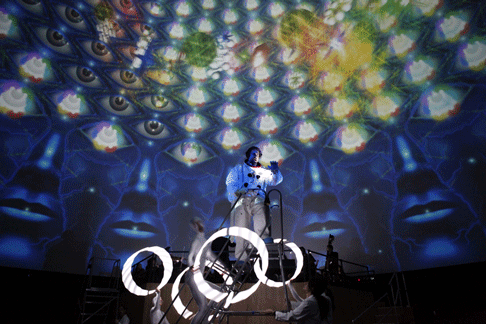 Pictured: Marco Nisticò
Pictured: Marco Nisticò
NG: And wasn’t she fantastic? But she’s not a household name
– yet. And Takesha [Takesha Meshé Kizart, who sang in L’Isola
Disabitata] already has a huge following. But I have to have some way in
which to raise the money because the reality of chamber opera is the
productions are expensive. A set does not cost much less in a small theater
than it does in a big theater, especially since we work with unions –
always. The revenue possibilities are far, far, far less – we have a
theater at Henry Street of 325 seats, at John Jay of 600 seats, versus the City
Opera or the Met. So there’s no way there’s a good feasible
financial model for this. Which is a long way of saying that ticket prices,
even with sold-out houses, never pay more than twelve to fifteen percent.
JY: Ouch.
NG: Ouch. So the rest has to come from donations, either from foundations or
from individuals. It’s never easy, but people respond to quality, and
I’m not going to sacrifice the quality. I’ll reduce the number of
productions – which I’ve done – but I won’t reduce the
quality. That’s what foundations respond to – and government as
well. When Bloomberg had all the arts agencies in the city reevaluated for the
first time in decades, the amount of money we got from the city grew
exponentially all at once. Prior to that, the amount you got from the city was
based on how long you’d been around. So we went from a few hundred
dollars to many thousands in one fell swoop, because they got rid of a lot of
companies and rewarded the ones they considered did work they wanted to
continue.
But it’s a lot of money to raise, every year and for each production
and we have no endowment, we haven’t been around long enough – our
tenth year is 2011. It takes a while to build things up. Our donors have been
very, very loyal. We’ve lost very few, and gotten a lot more donations at
the lower and middle levels. I think people in my income bracket have perceived
the danger to the arts and are doing their part to keep projects that they care
about afloat. So financial considerations are huge for us. We must choose our
repertoire on all of those factors.
JY: I thought La Bella dormente nel Bosco was one of your triumphs.
I took my mother –
NG: Did she like it?
JY: Loved it. How could anyone not love it?
NG: I’d been to see Basil Twist’s production of
Petrushka at Lincoln Center and loved it. I’d known about puppet
opera – in theory. Something rang a bell, and I thought, I’d love
to collaborate with this guy.
JY: Haydn’s Baucis und Philemon.
NG: The other way around – Philemon und Baucis. But yes
– that was one of the pieces I considered, actually. I researched it, and
among the pieces that had been conceived for puppets was Respighi’s
Bella dormente. So I researched that, approached Basil about doing it,
but then reading the score I realized this was going to be big – no way
could we raise the funds. That’s when I went to Nigel Redden at Lincoln
Center Festival about co-producing it with him.
JY: Whom you knew through Mostly Mozart?
NG: No. I didn’t know him at all. I just wrote him a letter. And he
called me and we discussed it, and he pursued it. After he’d looked into
it further, he realized that even Lincoln Center couldn’t afford it on
their own, so he brought in Spoleto Festival USA. It became a production of
Lincoln Center Festival, Spoleto USA, in partnership with – I can’t
remember the exact wording – Gotham Chamber Opera. So they paid by far
the lion’s share of the costs – which were enormous. Basil did a
fantastic job, the marionettes were amazing. We have another production planned
with marionettes.
JY: I’m delighted to hear that. Should I ask what it is?
NG: Sure. This is for early autumn of 2010. Montsalvatge’s El Gato
con Botas – “Puss in Boots.” We decided it would be best
served by humans doing the human characters and puppets doing the non-human
characters, such as the ogre and – obviously – the cat, whereas, in
Bella dormente, there were life-size marionettes of human characters
as well as the non-human characters. Blind Summit, who did the marionette in
the Met’s Butterfly, are going to do the many puppets, and
Moisés Kaufman will direct the human characters, so it will be a co-production
with his Tectonic Theater Project. Moisés’s first language is Spanish,
he’s deeply musical as you probably know if you’ve seen 33
Variations. The production will have two casts, a Spanish cast and an
English cast, and we’re designing it to travel.
That’s one way we’re facing the present economic crisis –
because we want each production to be at least as wonderful as the last, but
with less financing what do you do? You can’t let the audiences down. One
solution is co-productions. We’ve wanted to do co-productions for a long
time but two things militated against that. First, we weren’t on the
radar of the big companies that had money. And another thing, the big companies
that had money – had money! They weren’t interested in co-producing
with anybody. But times have changed. Those companies have less money, and
we’re more on the national radar. So a few are really interested, and
we’re in discussion about partnering for every production from now on
– for a while.
JY: And some things would travel.
NG: Presumably.
JY: I kept thinking, at Bella dormente – though were plenty
of kids in the audience –how much they would love it – as we all
know, they’ve cut the exposure of kids to classical music in the schools
–
NG: So many companies have been interested in reviving Bella
dormente, and there’s nothing we’d like more. But it’s
totally impossible financially. Thirty-something in the pit, a chorus of
– maybe you can do sixteen – and seven world-class singers plus the
puppeteers for every performance. It was designed only to be done in a small
theater, with revenues of next to nothing. So it’s physically impossible.
All these companies have wanted to do it but can’t.
Whereas, El Gato con Botas has a small orchestra and no chorus, so
it’s designed specifically to move around. I mean, it’s not going
to be bare bones. It will require a certain number of puppeteers, and
I’ve got to do it with a certain number of players in the orchestra. But
it’s possible, it’s not impossible.
We’re only going to be able to do two productions this year, but our
goal at some point is to get it to three. I think that’s all I can do and
still have real quality control. For each solo role, I probably hear fifty
people? Till I hear exactly what I want. So it takes a lot of time to do it
properly.
JY: There are that many able singers around? How do they live?
NG: Oh, absolutely! A couple of weeks ago, I went to the finals of the
George London Competition, and there were about thirty singers or more. And
next week are the Richard Tucker auditions, and that’s only by
nomination, and it’s two full days, so there are going to be about sixty
singers. There will be some overlap. I used to be on the board of the Tucker
Foundation, so I’m involved with that organization. I always go to the
Met semi-finals, and every summer I hear the young artists at Caramoor,
Glimmerglass, Santa Fe – there’s a network. There are other
conductors whose opinions I trust, and we let each other know who’s
terrific.
The most we’ve ever done is three productions in a season. This year
we have another Haydn [Il Mondo della Luna], and then Puss in
Boots in early fall.
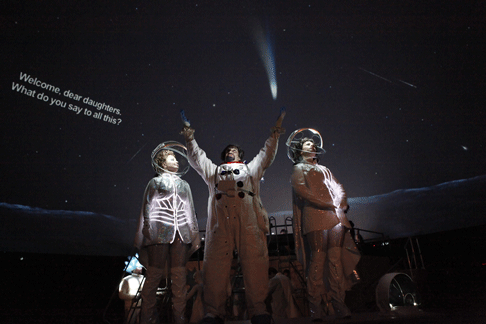 Pictured (left to right): Matthew Tuell (back), Albina Shagimuratova, Marco Nisticò, Hanan Alattar
Pictured (left to right): Matthew Tuell (back), Albina Shagimuratova, Marco Nisticò, Hanan Alattar
JY: I’m sorry to hear about the cutting back, but it’s the era
we live in.
NG: I think it’s a better solution than doing three productions
poorly.
JY: They were doing Il Mondo della Luna last year when I was in
Trieste, but in Paisiello’s setting of the same libretto Haydn used.
NG: That’s interesting! It’s much briefer, because he
wrote that for Catherine the Great, and didn’t she say that she only
wanted operas that ran an hour and a half? So all those St. Petersburg operas
are brief. But ours is going to be brief, too.
My theory about, say, the Handel operas that can go on and on and on, you
have two choices: If each singer is so wonderful that you can’t wait to
hear the next aria they sing, then it’s a fabulous evening. If you hear
the first aria and think, Oh God, do I have to listen to that all
evening? then it’s interminable. He wrote those things for singers; if
you’ve got the right singers, the evening flies by. If not, then
it’s torture. It’s that easy. Did you see our Arianna in
Creta? I wrote the ornamentation myself – with the singers. If
they’ve got great high notes and the middle voice isn’t so great,
then I put in lots of high notes – and vice versa.
JY: As every composer in history has done.
NG: Right. I mean, my job is to show off the singers – and the
composer. If I accomplish that then everybody’s happy.
I’m lucky. I love what I’m doing. When I talked to Bernstein
about being a conductor, he said, “Get the best people, and let them do
their job.” That’s what I try to do. Because somebody who’s
dedicated their life to being a lighting designer knows more about lighting
design than I do. And directing, and whatever. The only time that that’s
a problem is when there’s a conflict between one person doing their job
and another person doing their job. Then it’s time for me to step in. But
that doesn’t happen very often. I don’t think there’s been a
single person who’s worked with Gotham who would not be delighted to come
back. I go out of my way to get people who have a collaborative spirit, singers
or designers or whatever.
JY: And you’ve sung in such small spaces, you haven’t had to
compromise to get a huge voice.
NG: But there’s the opposite problem. In L’Isola
Disabitata, Takesha had to hold back all evening. She’s much happier
singing in big houses. She was very concerned about singing in John Jay. She
sings Trovatore; she’s a big Verdi voice. Did you hear her in
Forza at Caramoor? It was heaven.
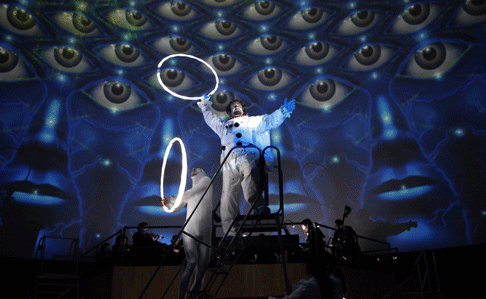 Pictured: Marco Nisticò (center)
Pictured: Marco Nisticò (center)
The other thing – I don’t cast entirely by myself, I always cast
with the director by my side because the director’s not paid well –
nor am I – so it’s very important to me that the director be as
excited about the singers as I am. So I always cast with the director, and in
most productions there were singers I was excited about and the director said
No, and sometimes there have been singers they were excited about and I said
No. But there’s always a way to make it work.
I learn from it. I remember being offered a job conducting operetta, and
telling my partner, “I don’t like operetta, I can’t
see myself doing this,” and he said, “Neal, you’re not a
conductor when you’re sitting in the living room.” And he was
right. I took the job and I was really wise to do it. Because operetta stuff is
really hard to conduct. There’s a lot of underscoring, and you’ve
got to figure out the timing so you’re done by the time the dialogue is
done and you’re about to start the aria. There are all these timing
issues you’ve got to work out. And huge balance issues. Lots and lots of
rubato. So I really respect people who do that and make music out of it. It was
good experience for me.
GOTHAM
CHAMBER OPERA,
in partnership with
the American Museum of Natural History,
and in association with American Repertory Theater,
presents
IL
MONDO DELLA LUNA
(The World on
the Moon)
An opera by Joseph Haydn
At The Hayden
Planetarium
Rose Center for Earth and Space
American Museum of Natural History
West 81st Street
(between Central Park West and Columbus Avenue)
January 19 - 28, 2010
Tuesday, January 19 at 7:30pm (Opening Night)
Wednesday, January 20 at 8pm
Monday, January 25 at 8pm
Tuesday, January 26 at 8pm
Wednesday, January 27 at 8pm
Thursday, January 28 at 8pm
Credits
Conductor: Neal Goren
Director: Diane Paulus
Video and Production Design: Philip Bussmann
Costume Design: Anka Lupes
Hair and Makeup Design: Hagen Linss
Associate Director: Andrew Eggert
Cast
Clarice: Hanan Alattar
Flaminia: Albina Shagimuratova
Lisetta: Rachel Calloway
Ecclitico: Nicholas Coppolo
Cecco: Matthew Tuell
Ernesto: Timothy Kuhn
Buonafede: Marco Nisticò
![Nicholas Coppolo and Hanan Alattar [Photo by Richard Termine courtesy of Gotham Chamber Opera]](http://www.operatoday.com/IL-MONDO-Photo-1-small.gif)





